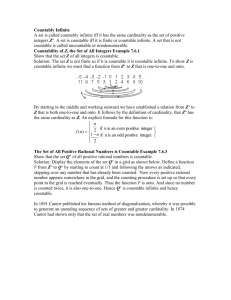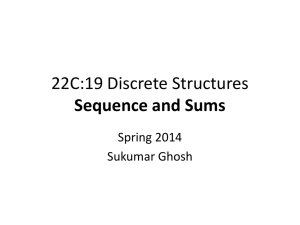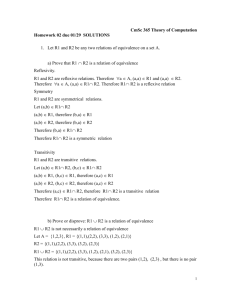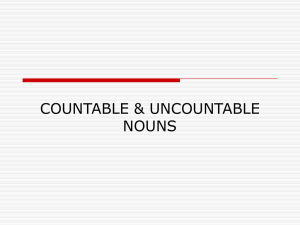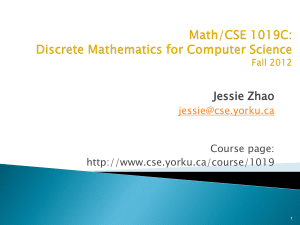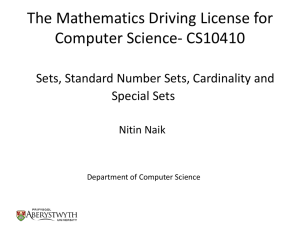CountableSets1
advertisement
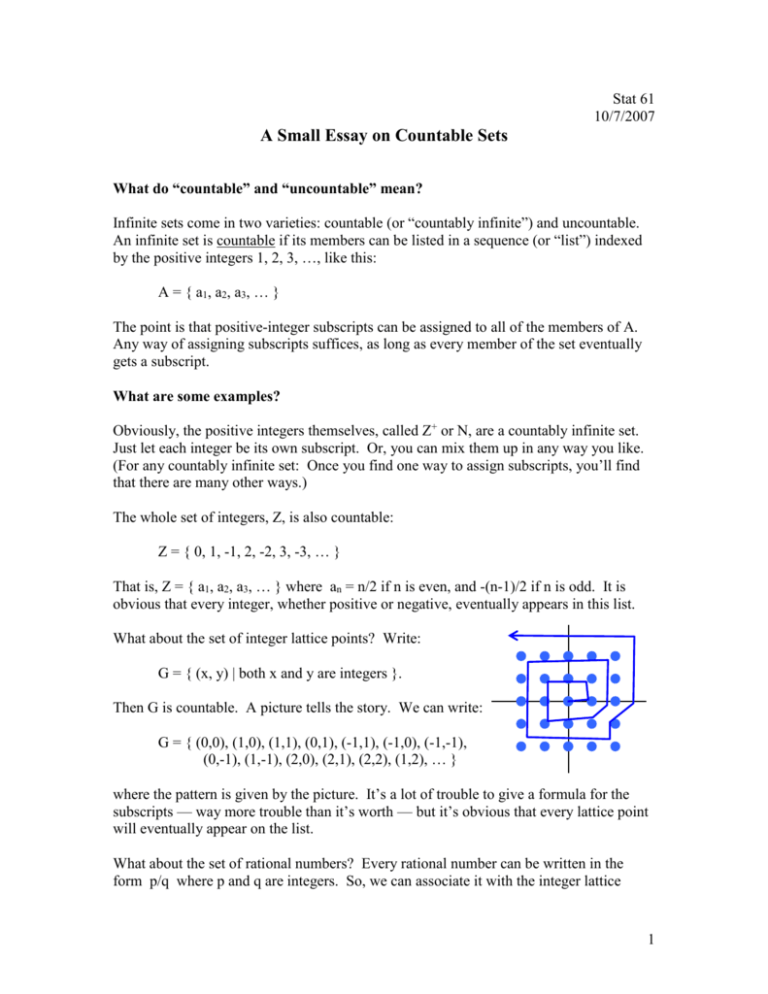
Stat 61
10/7/2007
A Small Essay on Countable Sets
What do “countable” and “uncountable” mean?
Infinite sets come in two varieties: countable (or “countably infinite”) and uncountable.
An infinite set is countable if its members can be listed in a sequence (or “list”) indexed
by the positive integers 1, 2, 3, …, like this:
A = { a1, a2, a3, … }
The point is that positive-integer subscripts can be assigned to all of the members of A.
Any way of assigning subscripts suffices, as long as every member of the set eventually
gets a subscript.
What are some examples?
Obviously, the positive integers themselves, called Z+ or N, are a countably infinite set.
Just let each integer be its own subscript. Or, you can mix them up in any way you like.
(For any countably infinite set: Once you find one way to assign subscripts, you’ll find
that there are many other ways.)
The whole set of integers, Z, is also countable:
Z = { 0, 1, -1, 2, -2, 3, -3, … }
That is, Z = { a1, a2, a3, … } where an = n/2 if n is even, and -(n-1)/2 if n is odd. It is
obvious that every integer, whether positive or negative, eventually appears in this list.
What about the set of integer lattice points? Write:
G = { (x, y) | both x and y are integers }.
Then G is countable. A picture tells the story. We can write:
G = { (0,0), (1,0), (1,1), (0,1), (-1,1), (-1,0), (-1,-1),
(0,-1), (1,-1), (2,0), (2,1), (2,2), (1,2), … }
where the pattern is given by the picture. It’s a lot of trouble to give a formula for the
subscripts — way more trouble than it’s worth — but it’s obvious that every lattice point
will eventually appear on the list.
What about the set of rational numbers? Every rational number can be written in the
form p/q where p and q are integers. So, we can associate it with the integer lattice
1
point (p, q) in the previous example. When we construct the list, we have to skip some
of the pairs… like (1, 0), of course, since 1/0 isn’t a rational number, and also pairs like
(3, 6), since 3/6 is the same rational number as 1/2 and has already been listed. But we
can still construct a list by this method, so the rational numbers are a countable set.
What are some examples of sets that aren’t countable?
The set of real numbers is uncountable. So is any interval of real numbers (except
singletons, of course, and the empty interval).
The proof isn’t obvious, but it’s very beautiful. [Skip it if you like. But come back
sometime.]
Consider the interval half-open interval [0,1). We have chosen this interval for
convenience, because every number in the interval has a decimal representation that starts
with “0. …” and any decimal representation that starts with “0. …” represents a number
in the interval.
We’ll prove that the numbers in this interval cannot be written as a sequence, indexed by
the positive integers.
We’ll prove this by contradiction. Suppose I claim to have formed a list (=sequence) of
numbers in the interval, with subscripts from Z+:
r1, r2, r3, r4, …
Then you can find a number x which is not on my list, by specifying all its digits, as
follows.
(a) If the first digit (to the right of the decimal point) of r1 is “2”, then the first
digit of x is “3”. Otherwise, the first digit of x is “2”.
(b) In general, if the n-th digit if rn is “2”, then the n-th digit of x is “3”, and
otherwise the n-th digit of x is “2”.
For example, if my sequence is
e-2, pi/6, sqrt of (1/2), 1/19, …
(or, roughly:
0.71828…, 0.52360…, 0.70711…, 0.05263…, … )
then your number is
x = 0.2322…
2
To find more digits of x, you would only have to see more terms of my sequence.
Now, behold: Your number x is not on my list. That’s because
(a) x is different from r1 because their first digits are different.
(b) x is different from r2 because their second digits are different.
(c) In general, x is different from rn because their n-th digits are different.
So, x is different from every number on my list. My list didn’t include all the numbers in
[0,1) after all. Since you can do this with any list, we conclude that it is impossible to
arrange the numbers in [0,1) in a sequence indexed by the positive integers. So, [0,1) is
uncountable. (End of proof.)
What’s going on is that the real numbers are actually a “bigger” set — a higher order of
infinity — than the integers. You can count the integers, but you can’t count the real
numbers.
Are there other examples of uncountable sets?
Yes, there are uncountably many examples. Since we care about sets of sets (or, to be
less confusing, collections of sets), let’s describe some uncountable collections of sets:
The collection of all intervals in R
The collection of all singletons (one-point subsets) in the
interval S = [0, 60)
The collection of all intervals of the form (-x, x) where x is positive
The Cantor set
The collection of all subsets of R3.
Why does this matter in a probability class?
The additivity axiom applies only to countable (or finite) collections of sets.
That second example above — the collections of singletons in S = [0,60) — is important
to us. In class we constructed a “uniform probability measure” on S, with the probability
measure defined by
P ( [a, b] ) = (b – a)/60
for every interval with b ≥ a. Singleton sets are intervals of the form [a, a], so they all
have measure (a-a)/60 = 0.
3
Those singleton sets are pairwise disjoint, and their union is all of S. So, if the collection
of singleton sets were finite or countable, then the additivity axioms would apply and we
would conclude that
P ( S ) = P ( union of all the singletons )
= Sum of [ P(s) ], for all the singletons s
= Sum of [ lots of zeros ]
= 0.0.
This would be a contradiction, because another axiom forces P(S) = 1.
Fortunately, since the collection of singletons isn’t countable, we don’t have this
problem. Continuous uniform distributions are very important in probability. Without
the distinction between countable and uncountable sets, we couldn’t have uniform
distributions.
(Actually, there’s a worse problem with trying to apply the additivity axiom to
uncountable unions. Look at the sum in the “equation” above — it is a sum of
uncountably many numbers. We don’t have any theory about how to add uncountably
many numbers. Much of calculus was about adding sequences of numbers. But
sequences can have only countably many terms, so our theory of addition only allows us
to add countable sets of numbers. The sum in the equation above involves an
uncountable set of numbers. It looks easy because all the terms are zero, but in a more
general example we would not even know what this sum means.)
Does “countable” mean the same as “countably infinite”?
All sets are of three kinds: finite; countably infinite; uncountable.
Some mathematicians use “countable” to mean “countably infinite,” and some
mathematicians use “countable” to mean “finite or countably infinite.” So, if you want to
be absolutely clear, you should only say what you mean: “countably infinite” or “finite or
countably infinite.” (Redundancy is not as bad as being misunderstood.)
What does “discrete” mean?
In a probability class it means “finite or countably infinite.” But beware: the word
“discrete” means other things in other areas of math.
(end)
4
